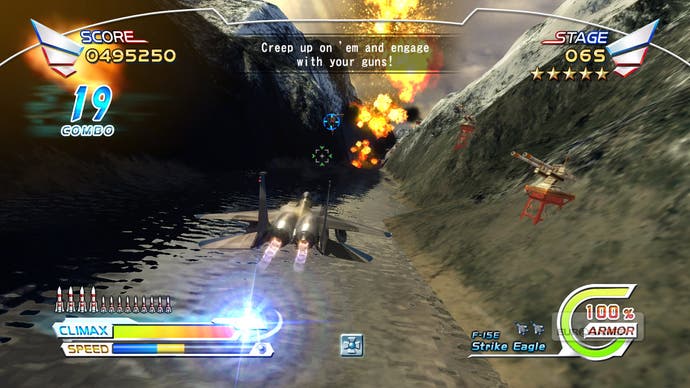After Burner Climax
Mile high club.
As with all After Burner titles, movement is limited to an into-the-screen run, so you are restricted to moving around the screen while the camera flies along a fixed path; there's no free dodging and weaving through a 3D environment. Perform a sharp bank in the opposite direction to the one you're currently moving in, and you'll execute an evasive roll, useful for dodging incoming missiles but the only acrobatic move in the game.
These basic inputs are bolstered by Climax Mode, a slow-motion focus move that can be activated every time the associated gauge fills. During Climax Mode, time slows and the lock-on cursor expands allowing you to target multiple enemies at once and take them down en masse. A numerical counter shows how many enemies are on screen at that exact point and, if you manage to target all of them, you earn a score boost for the effort.
After Burner Climax's arcade heritage is obvious, not just in the busy HUD filled with multipliers and combo counters, but also in the overwhelming odds. Indeed, it would take a player of prescient reactions to make it through an entire run without using an extra credit. This is, after all, a game explicitly designed to take your money in 60-second increments.

To offset the unfair challenge, the parameters of play in the basic arcade mode can be edited via EX Options. These options allow you to increase the number of credits in the game, or increase the power of your weaponry, and unlock when you meet certain criteria. Complete the game 10 times, for example, and you can activate an auto lock-on feature.
EX Options work a lot like an arcade machine's dipswitch settings, some even altering deep systems, such as the window of opportunity for scoring combos. So while useful for evening the game's tall challenge, these features do break the scoring balance. As a result, high score play is limited to Score Attack mode, where EX options are banned and the playing field between players is level.

With no options for multiple players, longevity is restricted to high-score challenge and attempting to unlock all of the EX Options. For all its speed and visual attraction, Climax lacks the tactile thrill of OutRun's drifting and can often feel more like a frantic scramble to paint the screen with your cursor than a measured challenge.
The lack of any set-pieces and the anticlimactic ending make this feel like a game created on something of a tight budget. But despite all this, the core systems tap into ancient, compelling arcade wells - and for those who take the time to master the tall but relatively short learning curve, Climax offers enough thrills and challenge to justify its price tag of 800 Microsoft Points (£6.80/€9.60) or equivalent. Moreover, the chance to pilot the F-15 of an 8-year-olds dreams - all glory, no perspiration - is priceless.








